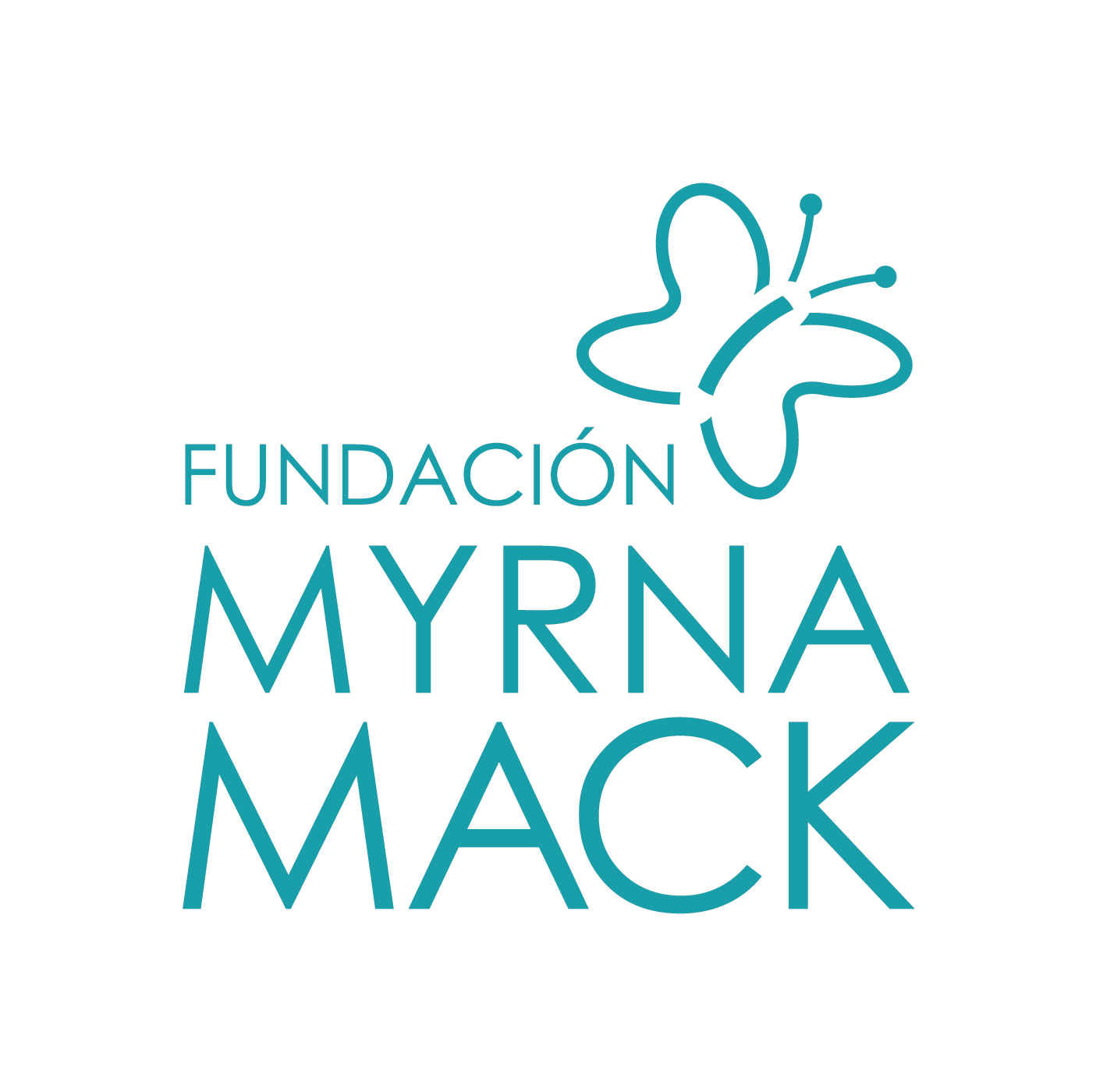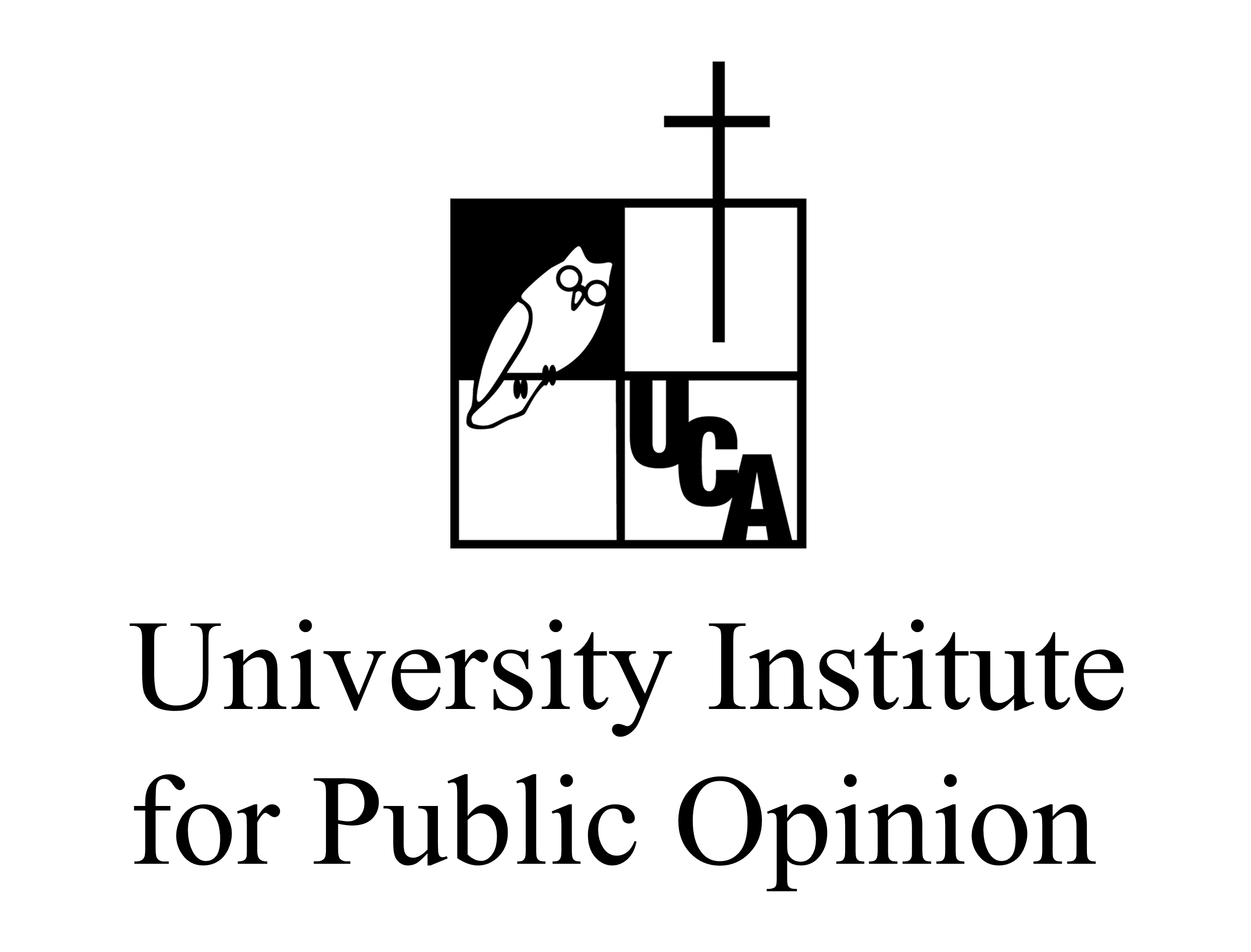Combatting Corruption
CENTRAL AMERICA MONITOR:
EVALUATING PROGRESS
Central America’s Northern Triangle region is struggling with violence, corruption and impunity.
Scroll for the key findings or to find links to download the full reports under each area of progress.
Evaluating progress in Central America
As Guatemala, El Salvador, and Honduras struggle with high levels of violence and insecurity, systemic corruption, and widespread impunity, it’s critical that we find ways to assess how the policies and strategies being implemented in the region are contributing to the strengthening of the rule of law, improving transparency and accountability, and to reducing violence and insecurity. Using a comprehensive series of indicators, the Central American Monitor aims to measure progress and identify trends over time in eight key areas directly relevant to rule of law and security, thus providing critical information that can inform policies and strategic investments in the region.
The Washington Office on Latin America (WOLA), the Myrna Mack Foundation (FMM) of Guatemala, the University Institute for Public Opinion (Iudop) of the José Simeón Cañas Central American University (UCA) of El Salvador, the University Institute on Democracy, Peace and Security (IUDPAS) of the National Autonomous University of Honduras (UNAH) have developed a series of qualitative and quantitative indicators to evaluate progress in Central America in eight key areas.
Combatting Corruption
Areas of progress
1.
Levels of Public Trust
During the 2014-2017 period, El Salvador was rated extremely low in Transparency International’s Corruption Perceptions Index, with scores between 33 to 39 points (Transparency International uses a scale between 0 and 100, 0 meaning highly corrupt, and 100 meaning non-corrupt). This is well below the annual average reported by the international organization. The accompanying table shows El Salvador’s performance in this index.
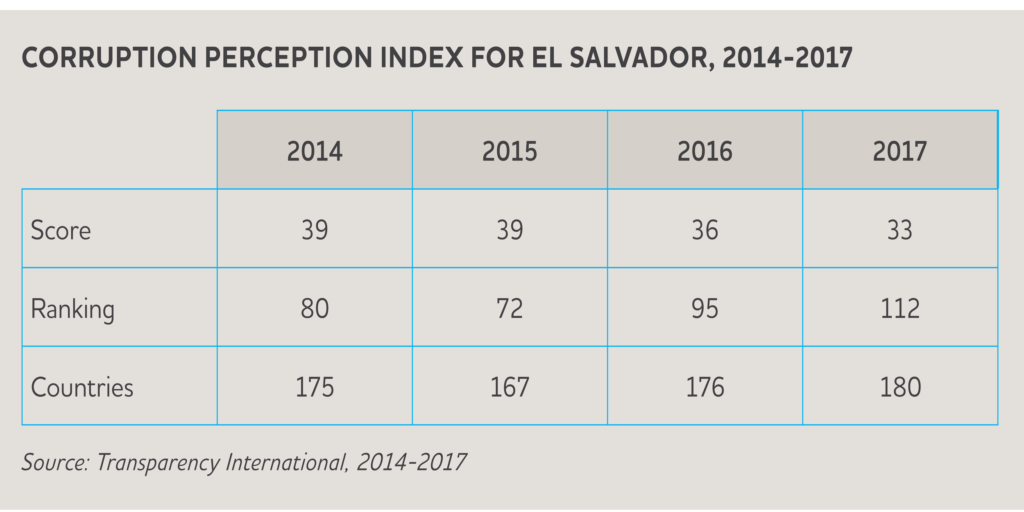 Public opinion polls show the main problems that citizens identify in the country are crime and the economy. However, since 2013, the proportion of Salvadorans who identify corruption as the country’s main problem has continuously grown. This demonstrates a greater awareness about corruption among the public, as illustrated in the accompanying graph.
Public opinion polls show the main problems that citizens identify in the country are crime and the economy. However, since 2013, the proportion of Salvadorans who identify corruption as the country’s main problem has continuously grown. This demonstrates a greater awareness about corruption among the public, as illustrated in the accompanying graph.
 Public opinion polls show the main problems that citizens identify in the country are crime and the economy. However, since 2013, the proportion of Salvadorans who identify corruption as the country’s main problem has continuously grown. This demonstrates a greater awareness about corruption among the public, as illustrated in the accompanying graph.
Public opinion polls show the main problems that citizens identify in the country are crime and the economy. However, since 2013, the proportion of Salvadorans who identify corruption as the country’s main problem has continuously grown. This demonstrates a greater awareness about corruption among the public, as illustrated in the accompanying graph. Combatting Corruption
Areas of progress
2.
Scope and Implementation of Legislation to Combat Corruption
The oldest and most problematic secondary legislation in recent years is the 1959 Law on Illicit Enrichment of Public Officials and Employees. There is a delay regulating actions that may constitute acts of corruption, especially regarding asset declaration and illicit enrichment. The outdated law still levies fines and infractions in colones, a currency that El Salvador has not used since 2001. The law establishes fines which range from $11.43 to a maximum of $1,142.86.
El Salvador made strides in establishing regulations allowing authorities to seize illegally obtained assets and re-purpose them for state use. In 2017, the Constitutional Chamber of the Supreme Court overruled a reform adopted by the Congress that sought to put in place a 10-year statute of limitations for asset seizures and recovery.
Combatting Corruption
Areas of progress
3.
Advancements in Criminal Investigations
Between 2014 and 2017, the government received complaints for 5,004 corruption related cases. Of these cases, 565 resulted in a dismissal, with the court suspending criminal proceedings due to a lack of evidence.
Between 2014 and 2015, the Public Prosecutor’s Office opened investigations into 846 cases involving crimes related to the administration of justice, 452 of which went to trial. Prosecutors obtained a conviction in 86 cases. During the 2014-2017 period, 140 cases did not advance in court due to lack of evidence and resulted in some type of dismissal.
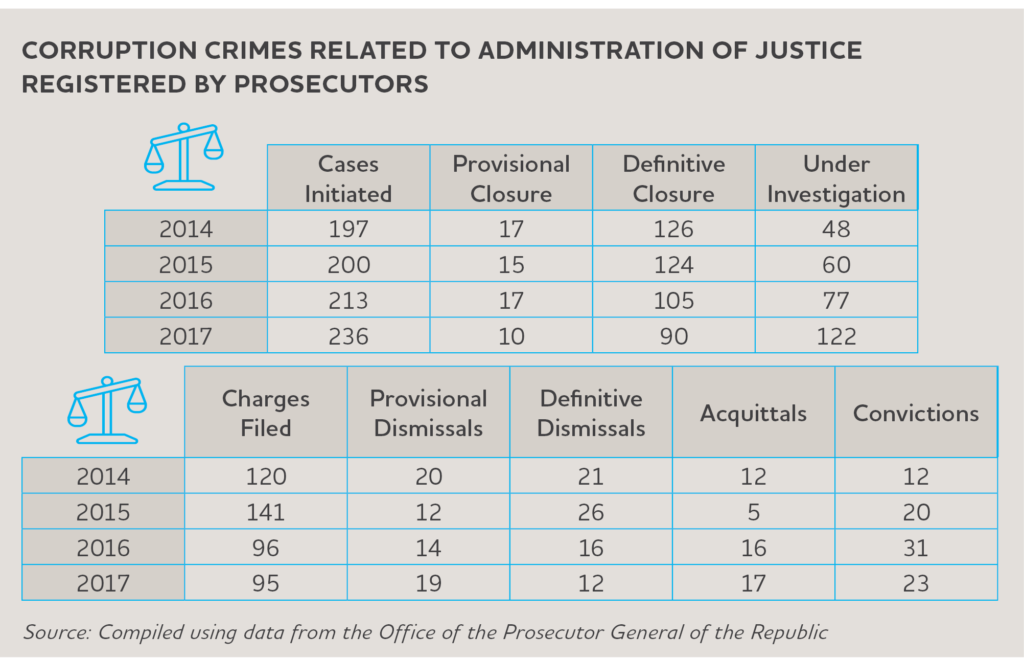 During the same period, authorities initiated investigations of 6,064 cases of alleged corruption in public administration, 1,723 of which went to trial. There were 538 convictions and 145 acquittals.
The crimes with the most number of acquittals are trafficking of prohibited objects in prison (92), bribery in exchange for committing criminal offense (12), peculation (7), and arbitrary acts (7), which together represent 81.4% of acquittals. No convictions were obtained for crimes of exaction, embezzlement, and illicit enrichment.
During the same period, authorities initiated investigations of 6,064 cases of alleged corruption in public administration, 1,723 of which went to trial. There were 538 convictions and 145 acquittals.
The crimes with the most number of acquittals are trafficking of prohibited objects in prison (92), bribery in exchange for committing criminal offense (12), peculation (7), and arbitrary acts (7), which together represent 81.4% of acquittals. No convictions were obtained for crimes of exaction, embezzlement, and illicit enrichment.
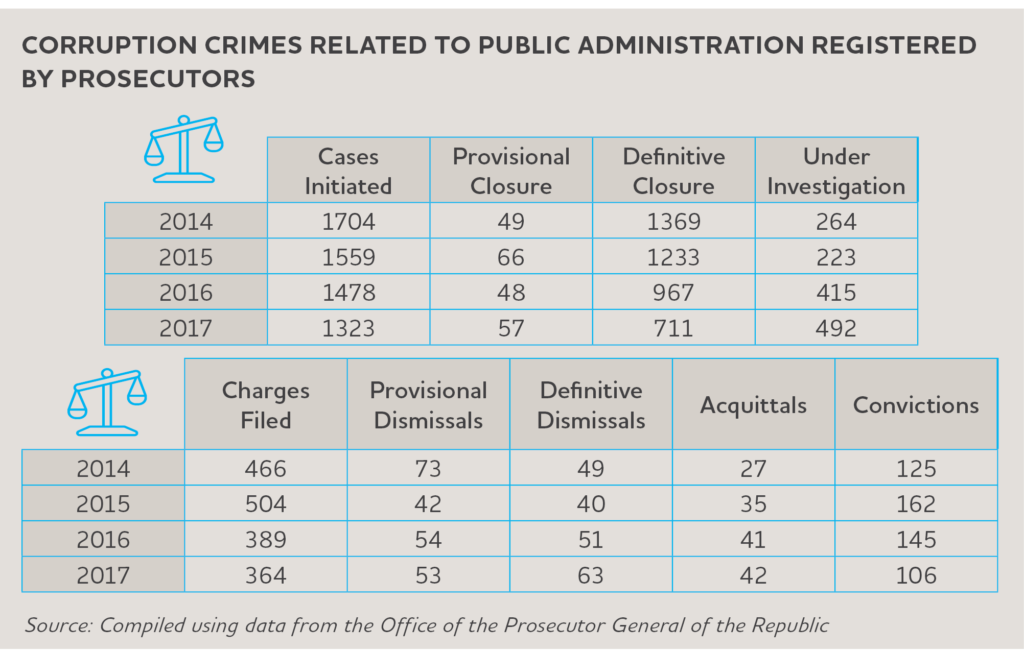 The Monitor was unable to obtain data from the judiciary, since, according to the Office of Information and Response of the Judiciary, the national trial courts stopped producing statistics of convictions and acquittals by type of crime.
The Monitor was unable to obtain data from the judiciary, since, according to the Office of Information and Response of the Judiciary, the national trial courts stopped producing statistics of convictions and acquittals by type of crime.
 During the same period, authorities initiated investigations of 6,064 cases of alleged corruption in public administration, 1,723 of which went to trial. There were 538 convictions and 145 acquittals.
The crimes with the most number of acquittals are trafficking of prohibited objects in prison (92), bribery in exchange for committing criminal offense (12), peculation (7), and arbitrary acts (7), which together represent 81.4% of acquittals. No convictions were obtained for crimes of exaction, embezzlement, and illicit enrichment.
During the same period, authorities initiated investigations of 6,064 cases of alleged corruption in public administration, 1,723 of which went to trial. There were 538 convictions and 145 acquittals.
The crimes with the most number of acquittals are trafficking of prohibited objects in prison (92), bribery in exchange for committing criminal offense (12), peculation (7), and arbitrary acts (7), which together represent 81.4% of acquittals. No convictions were obtained for crimes of exaction, embezzlement, and illicit enrichment.
 The Monitor was unable to obtain data from the judiciary, since, according to the Office of Information and Response of the Judiciary, the national trial courts stopped producing statistics of convictions and acquittals by type of crime.
The Monitor was unable to obtain data from the judiciary, since, according to the Office of Information and Response of the Judiciary, the national trial courts stopped producing statistics of convictions and acquittals by type of crime. Combatting Corruption
Areas of progress
4.
Functioning of Oversight Bodies
From 2014 to 2017, a total of 2,050 civil servants and public employees were investigated for violations of the Government Ethics Law. Of these, the courts only issued penalties for 7.3 percent (149 people).
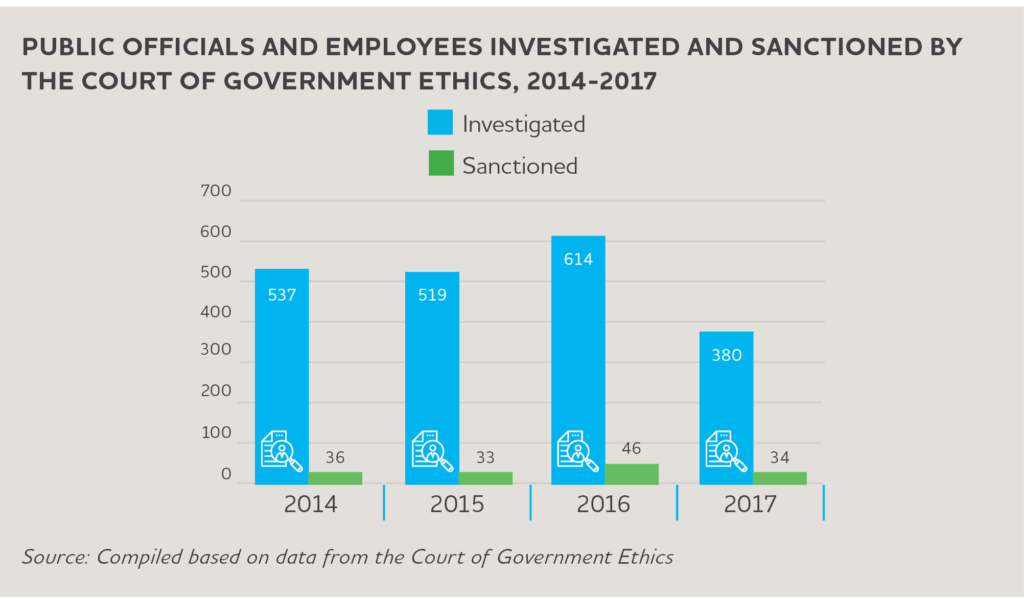 The Court of Accounts, the entity charged with auditing public funds, is one of the public agencies with the least amount of information publicly available concerning the investigations and procedures it carries out. The information available shows that the court received 682 complaints of irregularities between 2014 and 2017, mostly involving administrative and financial issues or irregularities concerning internal oversight of staff.
The Court of Accounts, the entity charged with auditing public funds, is one of the public agencies with the least amount of information publicly available concerning the investigations and procedures it carries out. The information available shows that the court received 682 complaints of irregularities between 2014 and 2017, mostly involving administrative and financial issues or irregularities concerning internal oversight of staff.
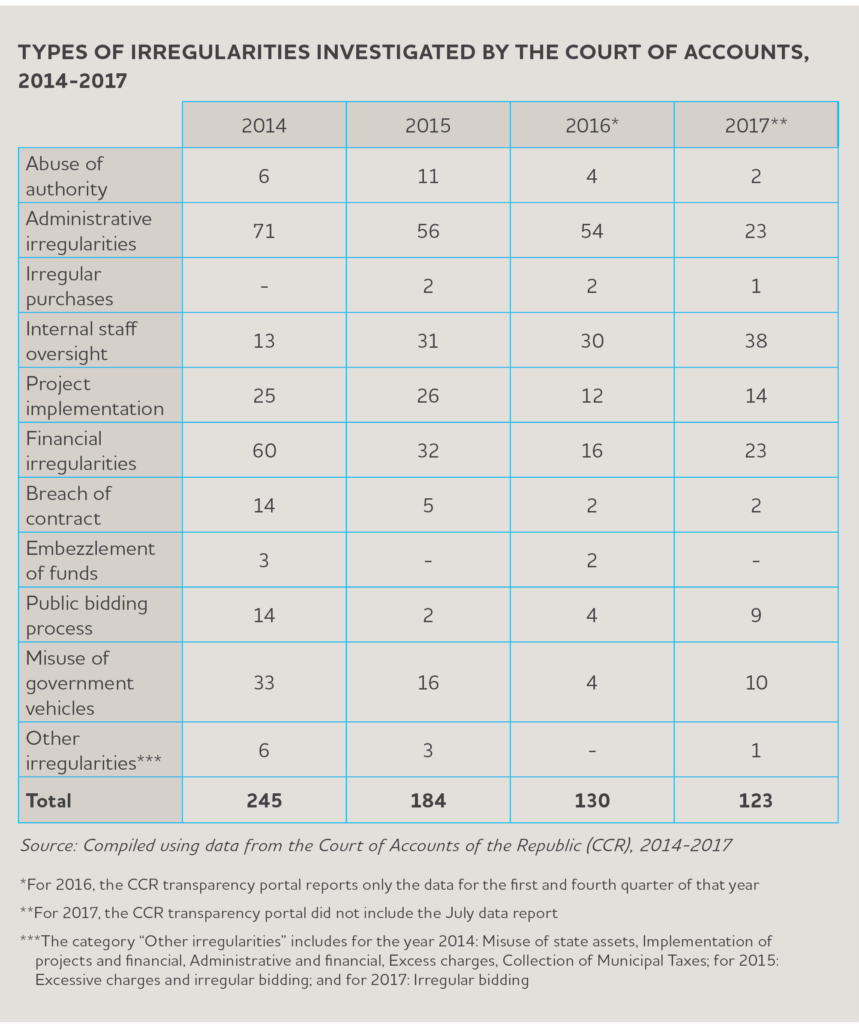
 The Court of Accounts, the entity charged with auditing public funds, is one of the public agencies with the least amount of information publicly available concerning the investigations and procedures it carries out. The information available shows that the court received 682 complaints of irregularities between 2014 and 2017, mostly involving administrative and financial issues or irregularities concerning internal oversight of staff.
The Court of Accounts, the entity charged with auditing public funds, is one of the public agencies with the least amount of information publicly available concerning the investigations and procedures it carries out. The information available shows that the court received 682 complaints of irregularities between 2014 and 2017, mostly involving administrative and financial issues or irregularities concerning internal oversight of staff.

GLOSSARY
The Washington Office on Latin America (WOLA), the Myrna Mack Foundation (FMM) of Guatemala, the University Institute for Public Opinion (Iudop) of the José Simeón Cañas Central American University (UCA) of El Salvador, the University Institute on Democracy, Peace and Security (IUDPAS) of the National Autonomous University of Honduras (UNAH) have developed a series of indicators to assess the progress in Central America in eight key areas. That progress will reflect both the commitment of Central American governments and the effectiveness of international assistance. The indicators include a combination of quantitative data and qualitative analysis in order to gain a more in-depth understanding of the changes taking place in each country. Data sources include official documents and statistics, surveys, interviews, and reviews of existing laws and regulations that will be systematically compiled.
WOLA, the Myrna Mack Foundation, Iudop, and IUDPAS developed these indicators in a months-long process that included review of international standards, consultation with experts, and consensus among all partners about the key issues to address.
Our goal is to provide an instrument that can help identify the areas of progress and opportunities for improvement shortfalls for of the policies and strategies being implemented on the ground in a form that is useful for policymakers, donors, academics, and the public. At the same time, we hope to provide analysis that can contribute to the evaluation of trends over time both within and between the countries of the Northern Triangle.
1
Strengthening the Capacity and Independence of Justice Systems
Capacity of the Justice System: Number of criminal justice officials, geographical coverage, workload, effectiveness, and public trust.
Internal Independence: Existence and implementation of a public, merit-based selection process free from external influence, a results-based evaluation system, and an effective disciplinary system.
External Independence: Size of budget allocated for the judicial sector and implementation of national and international protection measures for justice officials.
2
Cooperation with Anti-Impunity Commissions
Political Will and Level of Collaboration: Commitment of the state to collaborate and enable the work of the CICIG in Guatemala and the MACCIH in Honduras, demonstrated by the progress of emblematic cases, the approval of legislative reforms, and support for domestic counterparts working with these commissions.
3
Combating Corruption
Level of Public Trust: Degree of public trust in state institutions involved in efforts to prevent, identify, investigate, and punish corruption.
Scope and Implementation of Legislation to Combat Corruption: Classification of new crimes in criminal codes and reforms of existing anti-corruption laws to adhere to international standards.
Advancements in Criminal Investigations: Number of corruption cases filed, prosecuted, and resolved, as well as the progress made in emblematic cases.
Functioning of Oversight Bodies: Existence and capacity of external oversight bodies or agencies to combat corruption.
4
Tackling Violence and Organized Crime
Capacity Building: Existence and functioning of specialized anti-organized crime units, application of scientific and technical investigative methods, and functioning of judges or tribunals dedicated to the prosecution of organized crime
Advances in Criminal Investigations: The number of organized crime-related cases filed, prosecuted, and resolved, as well as the progress made in emblematic cases.
Crime Reduction: Convictions for homicides, extortion, and against criminal networks, as well as a reduction in serious and violent crimes.
5
Strengthening Civilian Police Forces
Functioning of Police Career Systems: Existence and effectiveness of police recruitment and promotion mechanisms, training processes, and disciplinary systems, as well as the structure of police bodies.
Allocation and Use of Budgetary Resources: Allocation and effective use of public funds and percentage designated for the wellbeing of members of the civilian police forces.
Community Relations: Public trust in the police, police-community relations, and relations with indigenous authorities.
6
Limiting the Role of the Armed Forces in Public Security Activities
Development and Implementation of a Concrete Plan: The design and implementation of a publicly accessible and verifiable plan with goals, timelines, activities, and clearly established indicators; repeal of legal norms authorizing participation of armed forces in public security, and access to information regarding payroll and assigned resources.
Conduct of Military Forces: Complaints, accusations, and sentences regarding human rights violations perpetrated by members of the armed forces and the level of public trust in the armed forces.
7
Protecting Human Rights
Investigation and Conviction of Human Rights Violations: Existence and functioning of specialized investigative units, number of complaints, prosecutions, and convictions, handling of emblematic cases, and degree of security forces’ collaboration with investigations.
Protection Mechanisms: Structure and functioning of domestic protection mechanisms and implementation of international protection measures for human rights defenders who have been victims of attacks or threats.
Hate Speech: Analysis of attacks and smear or defamation campaigns against human rights defenders.
8
Improving Transparency
Scope and Implementation of the ‘Law of Access to Public Information’: Type of information categorized as restricted or of limited access, period of classification, availability and quality of statistics related to security and justice, information requests granted and denied, and related fees.
Budget and Spending Transparency: Access to public information on budget allocations and spending on security, justice, and defense.
Disclosure of Public Officials’ Statement of Assets: Level of official compliance with disclosure norms, and the degree to which such statements are made available to the public.
METHODOLOGY
The Central America Monitor is based on the premise that accurate, objective, and complete data and information are necessary to reduce the high levels of violence and insecurity, and establish rule of law and governance in a democratic state. This will allow efforts to move beyond abstract discussions of reform to specific measures of change.
The Monitor is based on a series of more than 100 quantitative and qualitative indicators that allow a more profound level of analysis of the successes or setbacks made in eight key areas in each of the three countries. More than a comprehensive list, the indicators seek to identify a way to examine and assess the level of progress of the three countries in strengthening the rule of law and democratic institutions. The indicators seek to identify the main challenges in each of the selected areas and examine how institutions are (or are not) being strengthened over time. The Monitor uses information from different sources, including official documents and statistics, surveys, interviews, information from emblematic cases, and analysis of existing laws and regulations.
The indicators were developed over several months in a process that included an extensive review of international standards and consultation with experts. The eight areas analyzed by the Monitor include:

